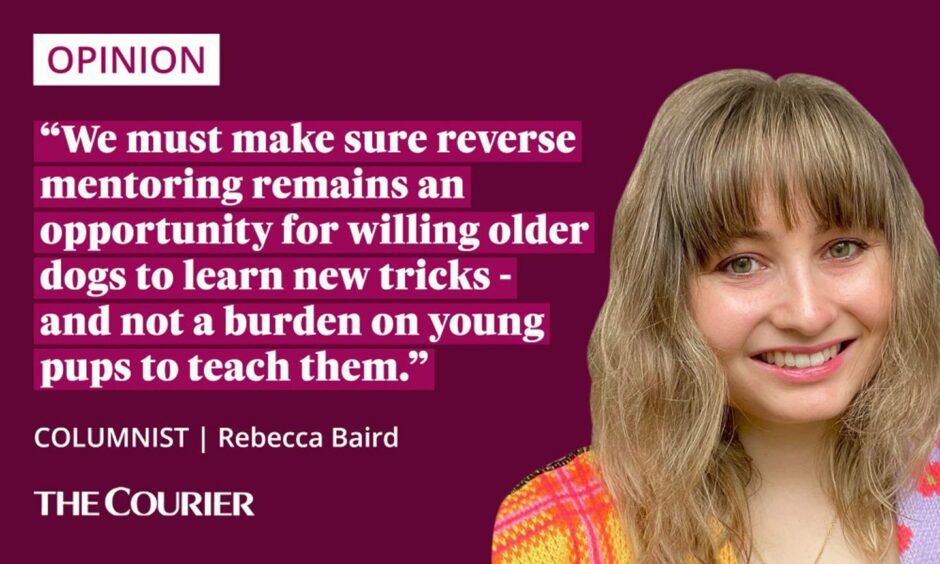Reverse mentoring is one of those workplace trends that seems like such an objectively good idea, there should be no need to advocate for the devil.
There is, however, always a need to advocate for young workers, so let’s get into it.
‘Reverse mentoring’ – where junior employees mentor senior ones, instead of traditional top-down mentoring – has been the buzzphrase of the last couple of weeks, as business gurus dole out advice on what workplaces should be aiming to do in 2023.
While the phrase (coined in the ’90s) used to refer to those who’d grown up with new technology helping their more senior colleagues get to grips with new digital developments, it’s now expanding its meaning to encompass a whole other set of skills – social ones.
And on paper, it totally makes sense.

As Gen Z enter the workforce and retirement age continues to increase, we’re seeing four generations working alongside one another for the first time since the Industrial Revolution.
And it’s fair to say that in general, younger employees are going to be more naturally acquainted with emerging – or shifting – attitudes around culture and identity politics than their more established coworkers.
That’s just the way it’s always been.
So in many ways, it’s refreshing to see workplaces recognising that and encouraging younger workers to help more senior colleagues navigate rapidly-changing cultural etiquettes and new ways of thinking across generational, gender and racial divides.
Clearing the air around taboo topics
I’ve been in mixed-aged teams most of my working life, and I genuinely love the relationships I form with older colleagues.
I don’t underestimate the wealth of professional experience that they can use to help guide me, and the conversations we’ve had about ‘taboo’ topics across the generational divide – immigration, money, Brexit, LGBTQ+ rights – have been some of the most enlightening and bonding moments of my career.
Personal anecdotes about events I am too young to remember help me understand viewpoints that are different from mine, and give context to the gaps in my knowledge.
A conversation I had with an older male colleague about sexual assault accusations stands out in my memory.
He made a throwaway remark of ‘that kind of thing ruining someone’s career’. Riled, I retorted that if true, the act itself could ruin the victim’s life. Instead of getting heated, we took the conversation out for a cuppa, and had a pretty open exchange of life experiences.
I learned things. He did too. And, maybe more importantly, we gained a bit more trust and respect for one another that day, because we took the time to look past the stereotypes we held – namely, that he was inflexible and out of touch, and that I was too sensitive.
So the well-meaning (annoying) optimist in me would love to believe that a more formalised reverse mentoring will be embraced across Scotland’s workplaces, from offices to factory yards.
But the narrow-eyed sceptic in me can see two glaring red flags in this shiny new ‘initiative’.
How do you teach the teacher?
The first, and the main concern, is that some folk simply aren’t interested in learning something new. And I get it.
If you’ve been in a job 20 years and understand the actual grunt work that needs to be done each day to keep things going, expanding your repertoire of digital skills and making nice with the phone-addicted interns may not be top of your list of priorities.
But having been that resident baby staffer in many a hospitality, retail and office role, I know all too well the frustrating refrain of: “I’m rubbish with all that computery stuff, just you do it, you’re young!”
Speaking from experience, I will happily demonstrate or explain the same thing time and time again – if someone is genuinely interested in understanding it.
But (unsurprisingly, to me), expert Jennifer Jordan from Switzerland’s Institute for Management Development, observed that “the programs that we saw that weren’t successful, the number one reason was that senior executives just didn’t take it seriously.”
She adds: “Very rarely did millennial or younger people not take it seriously.”
Age, seniority and a stubborn unwillingness to adapt is a pretty intimidating combination for junior workers to tackle in their reverse mentees (while also trying to establish themselves and learn the necessary core skills of their job).
With four generations now working together reverse mentoring can help expand diversity of thinking in the workplace https://t.co/B6Bf14TvQE
— Sabba Quidwai, EdD 🙌🏼 Designing Schools (@askMsQ) November 23, 2022
Which leads me nicely into concern number two: money.
Reverse mentor, accelerate burnout?
Mentoring was typically done top-down because not only did senior employees have the experience to guide juniors – they also had established enough reputations and pay packets to spend time doing so.
Young workers entering the professional world are scrabbling to prove their worth, often working long hours on minimal wages to do so. And even though ‘soft skills’ like reverse mentoring are highly sought-after by employers, they’re often forgotten about by ground-down bosses during hard discussions around wages.
So asking junior staff to reverse mentor (often uninterested) senior colleagues to fulfil 2023’s token HR tick-box, with rare pay increase and even rarer workload decrease, seems a surefire way to accelerate burnout, rather than create office utopia.
Employers seeing the value in their junior staff enough to want their input is a great step forward; but we must make sure reverse mentoring remains an opportunity for willing older dogs to learn new tricks – and not a burden on young pups to teach them.














Conversation